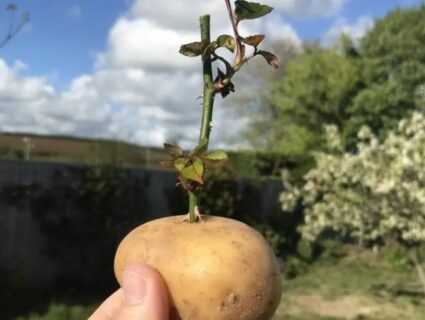:max_bytes(150000):strip_icc()/step06c-e15576a3b8db453085657c2f45ab7f80.jpg)
Their sweet aroma fills the air and their delicate, yet vibrant colors entice the eye.
Gertrude Stein said it best when she said, “A rose is a rose is a rose.”
Do you have a desire to fill your garden with sweet smelling roses? If so, propagating is the right way to go.
The experience will make you a better gardener, there is no doubt.
Don’t buy into the misconception that roses are difficult to grow from cuttings. It is really not that hard at all.
Unlike seeds that produce unique plants, rooted cuttings produce the spitting image of parent plants.
This is great if you want to carry on the legacy of a favorite family heirloom rose or you just have a variety that you really love or want to share.
WHAT YOU NEED TO KNOW BEFORE YOU START

By far, the most popular way to grow roses is from cuttings. Cuttings are defined as parts of the stem that are cut from the plant at various stages of growth.
Follow these tips for perfect rose propagation from cuttings.
While some plants are fussy about what type of cutting will root, roses are pretty flexible. You can freely take cuttings from the present year’s stems at three main growth stages:
Softwood cuttings: This is the most popular and easiest type of cutting and is taken when new stems are beginning to mature. The best cuttings are the same diameter as a pencil and taken just below spent blooms.
Semi-hardwood cuttings: When the new stems are partway mature they are considered semi-hardwood. Take these cuttings in summer or late fall.
Hardwood cuttings: Hardwood cuttings are slow to take but can still be successful. Take the cuttings in later fall or early winter when new stems are mature, hard and dormant.
SHOULD ROOTING HORMONE BE USED?
Your chances of success with any type of cutting can be improved if you use rooting hormone. It can make the task of getting new roots to start a bit easier and may eliminate frustration when used.
This is a high quality rooting hormone that can significantly increase your chance of success.
HOW TO TAKE CUTTINGS FROM ROSES
Because many things, such as weather can impact when softwood cuttings are best, don’t operate by a set date.
It is best to do a physical examination of the entire plant before taking a cutting to ensure that it is ready.
Always take cuttings from healthy and robust plants and do so in the early morning when plants are well hydrated.
The first step after the examination is to gather your supplies including:
- Clean bypass pruners
- Small bucket with warm water
- Rooting hormone (this is a good option)
- Shallow dish for rooting hormone
- Pencil or a small stick
SECURING ROSE CUTTINGS
- Choose a stem that is located in between a faded bloom and the base of the rose plant. Keep in mind that you can get several cuttings from one stem.
- Take off both the bloom and the stem tip. Cut on a 45-degree angle, slightly above the first set of leaves at the top. Make another cut just above the last set of leaves at the bottom. Place your cuttings in your bucket immediately.
- Cut your larger piece into smaller pieces that are about 8 inches in length. All cuttings should have at least four “nodes.”
- Remove all leaves except one set closest to the top of each cutting
